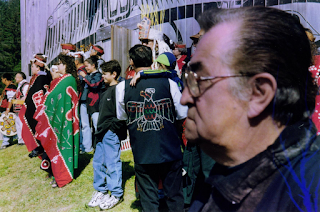Lauvstad came to NMSC from University College of the North, “my previous employer,” where he was involved in the development of training programs for 20 years in the post secondary world of education. He became active in delivering training to Aboriginal communities and Metis.” He is educated in administration of in post secondary education, born and raised in The Pas, “A city of about 7,000 people.”
The opportunities are open to all northern Manitobans, both genders, “primarily male taking the training, certainly,” and, “Typically they are people in their twenties. Those who enlist in the training enjoy a very high success rate. “The mine sector is particularly demanding a large number of employees,” but presently in Manitoba, hydro development is under way. “These are mega projects.”
Overall NMSC is engaged in employment development by training people with skills for use in an industrial setting, “So hydro is part of it.” The training demands are growing and NMSC is there to be a permanent agency. “We have three core staff members and then some contracts. We go year-round on the training. We get a base budget then we look for project funding.”
Don Nisbet, a program coordinator with the NMSC, discussed the training model which partners industry, government and the UCN in delivering site training. Typical programs include, Intro to Industry, Underground Miner Training, and Mineral Processing, and other.. NMSC works in partnership with UCN and industry sector partners and northern communities to find money, trainees, and jobs working in the various industries of mining, forestry, and electrical generation.
The upcoming mining academy opening in Flin Flon will offer classes later in 2011. “Premier Selinger paid a visit to facilities under construction,” while travelling in the area in mid August. “The academy is still in construction and we have no official completion date but NMSC continues running programs,” and sees the opening of the Academy as a real enhancement to our efforts to develop a skilled northern workforce.
The Flin Flon-based academy is for training in the mining industry, “Training is mine-related at the academy, basically hard-rock mining, Training is relevant to the job opportunities found in Northern Manitoba.” The NMSC is an initiative that is trying to take advantage of the demographics, “ If the academy wasn't built we would still be training, however, this new facility will allow us to dramatically expand the range of programs offered, improve the quality of the programs currently delivered and lay the groundwork to become a nationally utilized training educational centre, says Nisbet.
Bucko Lake Mine, operated by CaNickel Minerals, has hosted several NMSC training sessions in the past few years that produced some 57 graduates and the plan is for more training to start early in the new year. “Fifty one percent of the graduates are still working at the mine site."
Meanwhile the NMSC, which has been operating over four years, has also worked with Workplace Education Manitoba in bringing basic essential skills to their industry focused training. A product of this collaboration was the development of a custom entry level program entitled Introduction To Industry.
NMSC is working to “increase the pool of skilled labour from which we can draw, improving basic skills like math, and communications skills, then following up with more detailed training initiatives. We do not do it alone. We work with the resources we can find, often using agencies like Workplace Education Manitoba, industry partners, MKO, MMF, Training and Education Manitoba and UCN.
NMSC is mandated to continue in terms of the training and preparing a potential workforce for northern industry. The council’s member companies represent the largest resource based operations in Northern Manitoba and as such bring hundreds of potential jobs and career opportunities to people of the north. For the most part the training is free for the selected candidates and they need only bring a commitment in time and energy.
Some of the training requires living in mining camps and involves relocation. Most candidates to date have received some form of training allowance either through their band, EI, or the MMF. NMSC training initiatives remain diverse in area and specialization, basically focusing of the specific skills needed for the resource industries in northern Manitoba, be they related to forestry, mining or energy.






